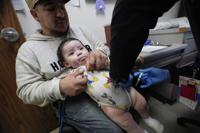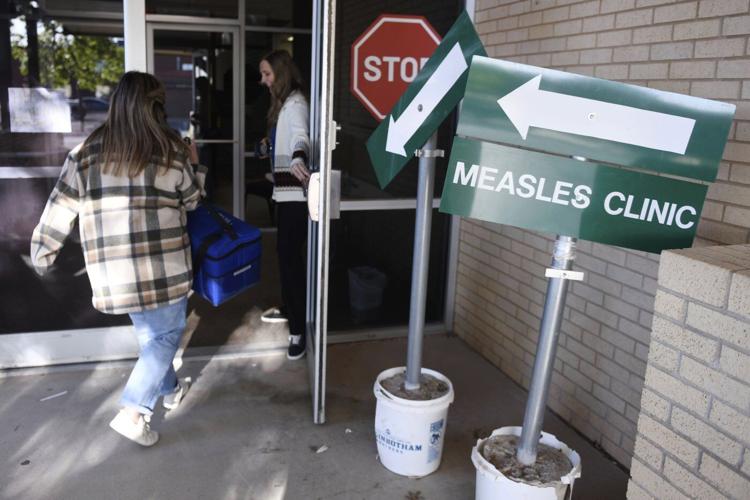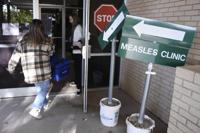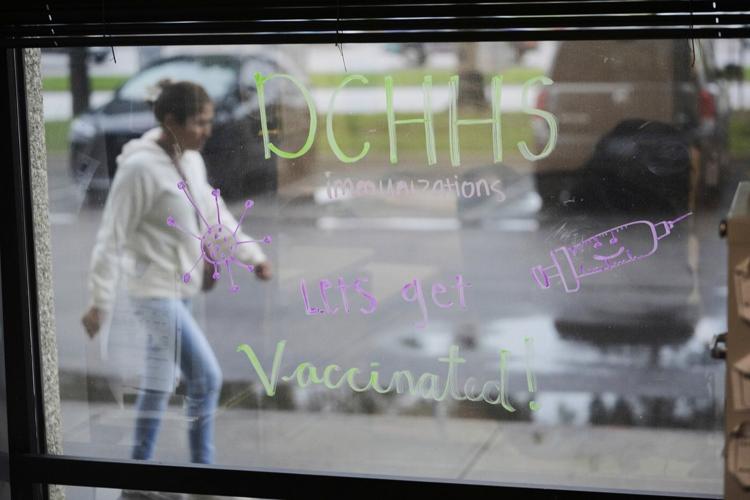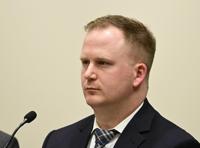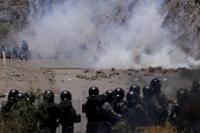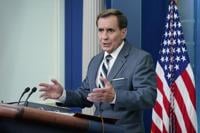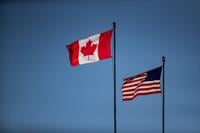The measles outbreak in West Texas didn’t happen just by chance.
The easily preventable , declared eliminated in the U.S. in 2000, ripped through communities sprawling across more than 20 Texas counties in part because health departments were starved of the funding needed to run vaccine programs, officials say.
“We haven’t had a strong immunization program that can really do a lot of boots-on-the-ground work for years,” said Katherine Wells, the health director in Lubbock, a 90-minute drive from the outbreak's epicenter.
Immunization programs nationwide have been left brittle by years of stagnant funding by federal, state and local governments. In Texas and elsewhere, this helped set the stage for the measles outbreak and . Now cuts to federal funding threaten efforts to prevent more cases and outbreaks.
Health departments got an influx of cash to deal with COVID-19, but it wasn’t enough to make up for years of neglect. On top of that, trust in vaccines has eroded. Health officials warn the situation is primed to get worse.
Recent cuts by the Trump administration have pulled billions of dollars in COVID-19 related funding — $2 billion of it slated for immunization programs for various diseases. Overseeing the cuts is Health Secretary Robert F. Kennedy Jr., who leading an . While Kennedy has said he wants his agency to prevent future outbreaks, he's also declined to deliver a consistent and forceful message that would help do so — encouraging people to vaccinate their children against measles while reminding them it is safe.
At the same time, lawmakers in Texas and about two-thirds of states have introduced legislation this year that would make it or otherwise put up barriers to ensuring more people get shots, according to an analysis by The Associated Press. That further undercuts efforts to keep infectious diseases at bay, health officials said.
The more than 700 measles cases reported this year in the U.S. have already surpassed last year’s total. The vast majority — more than 540 — are in Texas, but cases have popped up in 23 other states. . A 6-year-old girl from Gaines County, the center of the outbreak, the first measles death in the U.S. in a decade. An 8-year-old girl from the same town, Seminole, died earlier this month.
Children in the U.S. are generally required to be vaccinated to go to school, which in the past ensured vaccination rates stayed high enough to prevent infectious diseases like measles from spreading. But a have been skipping the shots for their kids. The share of children exempted from vaccine requirements has reached an all-time high, and just 92.7% of kindergartners got their required shots in 2023. That’s well below the 95% coverage level that keeps diseases at bay.
Keeping vaccination rates high requires
Though the outbreak in Texas started in Mennonite communities that have been resistant to vaccines and distrustful of government intervention, it quickly . There are across the country that could provide the tinder that sparks another outbreak.
“It’s like a hurricane over warm water in the Caribbean,” said Dr. Peter Hotez, co-director of the Texas Children’s Hospital Center for Vaccine Development in Houston. “As long as there’s warm water, the hurricane will continue to accelerate. In this case, the warm water is the unvaccinated kids.”
Flatlined vaccine funding in Texas
Lubbock receives a $254,000 immunization grant from the state annually that can be used for staff, outreach, advertising, education and other elements of a vaccine program. That hasn’t increased in at least 15 years as the population grew.
It used to be enough for three nurses, an administrative assistant, advertising and even goodies to give out at health fairs, Wells said. “Now it covers a nurse, a quarter of a nurse, a little bit of an admin assistant, and basically nothing else.”
Texas has for public health in the nation, just $17 per person in 2023, according to the State Health Access Data Assistance Center.
Vaccines are among the most successful tools in public health’s arsenal, preventing debilitating illnesses and lowering the need for expensive medical care. Childhood vaccines prevent 4 million deaths worldwide each year, according to the , which says the measles vaccine will save some 19 million lives by 2030.
U.S. immunization programs are funded by a variable mix of federal, state and local money. Federal money is sent to every state, which then decides how much to send to local health departments.
The stagnant immunization grant funding in Texas has made it harder for local health departments to keep their programs going. Lubbock’s health department, for example, doesn't have the money to pay for targeted Facebook ads to encourage vaccinations or do robust community outreach to build trust.
In Andrews County, which borders Gaines County, the biggest cost of its immunization program is personnel. But while everything has gotten more expensive, the grant hasn't changed, Health Director Gordon Mattimoe said. That shifts the burden to county governments. Some kick in more money, some don’t. His did.
The problem: keeping people safe from outbreaks requires high vaccination rates across a broad region, and germs don’t stop at county borders.
Andrews County, population 18,000, offers a walk-in vaccine clinic Monday through Friday, but other West Texas communities don’t. More than half the people who come to the clinic travel from other counties, Mattimoe said, including much larger places and Gaines County.
Some had to drive an hour or more. They did so because they had trouble getting shots in their home county due to long waits, lack of providers and other issues, Mattimoe said.
“They’re unable to obtain it in the place that they live. ... People are overflowing, over to here,” Mattimoe said. “There’s an access issue.”
That makes it more likely people won’t get their shots.
In Gaines County just 82% of kindergartners were vaccinated against measles, mumps and rubella. Even in Andrews County, where, at 97%, the vaccination rate is above the 95% threshold for preventing outbreaks, it has slipped two percentage points since 2020.
Vaccine funding crises aren’t only in Texas
The health departments millions of Americans depend on for their shots largely rely on two federal programs: Vaccines for Children and Section 317 of the Public Health Services Act. Vaccines for Children mostly provides the actual vaccines. Section 317 provides grants for vaccines but also to run programs and get shots into arms.
About , a safety-net program created in response to a 1989-1991 measles epidemic that sickened 55,000 people and killed 123. Section 317 money sent to state and local health departments pays for vaccines as well as nurses, outreach and advertising.
Health departments generally use the programs in tandem, and since the pandemic they’ve often been allowed to supplement it with COVID-19 funds.
The 317 funds have been flat for years, even as costs of everything from salaries to vaccines went up. A estimated $1.6 billion was needed to fully fund a comprehensive 317 vaccine program. Last year, Congress approved less than half that: $682 million.
This, along with insufficient state and local funding, forces hard choices. Dr. Kelly Moore, a preventive medicine specialist, said she faced this dilemma when directing Tennessee's immunization program from 2004 to 2018.
“What diseases can we afford to prevent and how many people can we afford to protect? Those decisions have to be made every year by every state,” said Moore, who now runs the advocacy group .
A rural clinic may have to be closed, or evening and weekend hours eliminated, she said. “It becomes difficult for them to staff the clinics they have and difficult for the people in those communities to access them, especially if they’re the working poor.”
At the same time, health officials say more funding is needed to fight misinformation and mistrust about vaccines. In a 2023 survey by the ��ɫֱ�� Association of County and City Health Officials, 80% of local health departments reported vaccine hesitancy among patients or their parents in the previous year, up from 56% in 2017.
“If we don’t invest in education, it becomes even more difficult to get these diseases under control," Moore said.
An unclear future given continuing cuts and hesitancy
Facing these headwinds, things got much worse in March when Kennedy’s health department canceled billions of dollars in state and local funding. After 23 states sued, a judge put a hold on the cuts for now in those states but not in Texas or other states that didn’t join the lawsuit.
But local health departments are not taking chances and are moving to cut services.
HHS said the money, allocated through COVID-19 initiatives, was cut because the pandemic was over. But CDC had allowed the money to be used to shore up public health infrastructure generally, including immunization programs.
Before he was confirmed as health secretary, Kennedy vowed . But in Texas, his department’s cuts mean state and local health departments are losing $125 million in immunization-related federal funding as they deal with the measles outbreak. A spokesperson for the federal health department did not respond to an AP request for comment.
Dallas County, 350 miles from where the outbreak began, had to cancel more than 50 immunization clinics, including at schools with low measles vaccination rates, said Dr. Philip Huang, the county’s health director.
Near the center of the outbreak, Lubbock’s health department said seven jobs are on the line because they were paid by those grants. Included in the affected work are immunizations.
Across the border in New Mexico, where the outbreak has spread, the state lost grants that funded vaccine education.
Kennedy’s cuts also hit vaccination programs in other states
It's still unclear how the recently announced $2 billion in cuts will affect immunization programs across the country, but details are starting to trickle out from some states.
Washington state, for example, would lose about $20 million in vaccination-related funding. Officials were forced to pause mobile vaccine efforts on their “Care-A-Van,” which has administered more than 6,800 COVID-19 vaccines, 3,900 flu vaccines and 5,700 childhood vaccines since July. The state also had to cancel more than 100 vaccine clinics scheduled through June, including more than 35 at schools.
Connecticut health officials estimate if the cuts stand, they will lose $26 million for immunization. Among other reductions, this means canceling 43 contracts with local health departments to increase vaccination rates and raise confidence in vaccines, losing vaccination clinics and mobile outreach in underserved neighborhoods, and stopping the distribution of vaccine-related educational materials.
Several of the 23 states , including Minnesota, Rhode Island and Massachusetts, cite losses to vaccine programs.
As the cuts further cripple already struggling health departments, alongside increasingly prominent and powerful anti-vaccine voices, doctors worry that vaccine hesitancy will keep spreading. And measles and other viruses will too.
“My whole life’s purpose is to keep people from suffering. And vaccines are a tremendous way to do that,” Moore said. “But if we don’t invest in them to get them in arms, then we don’t see their benefits.”
___
The Associated Press Health and Science Department receives support from the Howard Hughes Medical Institute’s Science and Educational Media Group and the Robert Wood Johnson Foundation. The AP is solely responsible for all content.


